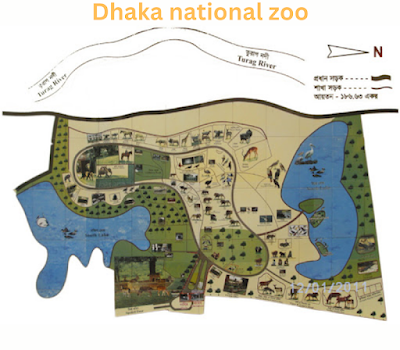Dhaka National Zoo, also known as Bangladesh National Zoo, is a prime tourist attraction and one of the most visited recreational sites in the country. The zoo plays a pivotal role in wildlife conservation, education, and entertainment. It has been a key center for research and zoological activities since its inception. With a diverse array of animals and a picturesque environment, the zoo is not only a place of fascination for animal enthusiasts but also a critical institution for promoting the importance of wildlife protection and sustainability.
Location and Establishment
Dhaka National Zoo is strategically situated in the Mirpur area of the capital city, Dhaka, Bangladesh. Its location in Mirpur makes it easily accessible to both local and international visitors. The zoo is spread across a sprawling 186 acres of land, making it one of the largest zoological gardens in South Asia. With its vast expanse, the zoo provides ample space for a variety of animal species to live in semi-natural habitats, allowing them to exhibit more natural behaviors compared to smaller enclosures.
The establishment of the Dhaka National Zoo dates back to the early 20th century, with the formal opening taking place on June 23, 1974. This marked a significant milestone in the history of zoological development in Bangladesh. The zoo was created to provide a sanctuary for animals while offering the public an opportunity to learn about and appreciate the country’s rich wildlife heritage. Over the years, the zoo has evolved significantly, becoming a major center for animal conservation and breeding programs.
Flora and Fauna: A Rich Collection
The zoo houses over 3,000 animals across more than 200 species, ranging from mammals, birds, reptiles, and amphibians to a small collection of fish and invertebrates. Some of the most notable inhabitants include Bengal tigers, lions, Asian elephants, leopards, deer, various species of monkeys, crocodiles, and an impressive range of bird species such as peacocks, ostriches, and a variety of waterfowls. The zoo is particularly known for its collection of indigenous species, showcasing the rich biodiversity of Bangladesh.
One of the unique aspects of Dhaka National Zoo is its focus on native species that are either endangered or threatened in the wild. By housing such animals, the zoo aims to raise awareness about the critical conservation needs of these species and promote breeding programs to bolster their populations. The zoo also plays host to several exotic species from different parts of the world, making it a diverse and enriching experience for visitors.
Challenges Faced by Dhaka National Zoo
Like many zoos around the world, Dhaka National Zoo faces numerous challenges. Some of these problems have persisted over the decades, posing significant hurdles to the smooth operation and management of the facility. The main issues can be categorized into the following:
Animal Welfare and Enclosure Conditions:
One of the foremost concerns at the zoo has been the quality of enclosures and the overall animal welfare standards. Inadequate space, lack of enrichment, and improper shelter designs have often been cited as major shortcomings. These issues not only impact the physical health of the animals but also affect their mental well-being, leading to stereotypic behaviors and decreased lifespan.Financial Constraints:
The zoo operates on a limited budget, which hampers its ability to invest in modern infrastructure, veterinary care, and research programs. While the zoo generates some revenue through ticket sales, it is not enough to cover the costs of maintaining a facility of this magnitude. This financial shortfall has a trickle-down effect, impacting everything from animal diet quality to habitat improvements.Lack of Skilled Staff and Management Issues:
Another challenge has been the shortage of trained personnel in zoo management and animal care. Managing such a diverse collection of animals requires specialized knowledge and expertise, which has sometimes been lacking. Moreover, instances of mismanagement and lack of accountability have led to public outcry and criticism of the zoo’s administration.Conservation and Breeding Programs:
While the zoo has initiated several breeding programs, the success rate has been inconsistent. Issues such as inadequate genetic diversity, poor breeding facility conditions, and lack of long-term planning have hindered the success of these programs. This is particularly concerning for species that are critically endangered and rely on captive breeding for their survival.Visitor Behavior and Public Perception:
In addition to internal issues, visitor behavior has also posed challenges. Littering, feeding animals, and overcrowding during peak times are common problems that affect the zoo’s environment. Moreover, the general perception of zoos as mere entertainment centers rather than conservation hubs diminishes their value as educational institutions.
Solutions and Efforts for Improvement
Despite these challenges, there have been concerted efforts to revitalize and modernize Dhaka National Zoo. Various initiatives have been undertaken to address the issues and transform the zoo into a world-class facility that prioritizes animal welfare, conservation, and visitor experience.
Upgrading Enclosures and Facilities:
One of the primary areas of focus has been the renovation of animal enclosures to meet international standards. The zoo administration, along with governmental support, has embarked on projects to expand enclosures, introduce naturalistic elements, and create species-specific habitats that mimic the animals’ natural environments. This has significantly improved the quality of life for several species and reduced stress-related behaviors.Enhanced Veterinary Care and Nutrition:
To address health concerns, the zoo has improved its veterinary facilities, equipped with modern diagnostic tools and treatment options. A dedicated team of veterinarians and animal nutritionists now oversee the dietary and health needs of the animals, ensuring a balanced and species-appropriate diet. Regular health check-ups and monitoring have become standard practice, reducing mortality rates and increasing the overall health of the zoo’s inhabitants.Staff Training and Capacity Building:
Recognizing the importance of skilled staff, the zoo has implemented various training programs for its employees. These programs focus on animal behavior, enclosure management, breeding techniques, and visitor engagement. Partnerships with international zoos and conservation organizations have been established to facilitate knowledge exchange and best practices.Conservation and Research Initiatives:
The zoo has strengthened its focus on conservation by participating in global breeding programs for endangered species. Collaborative efforts with universities and research institutions have been initiated to conduct studies on animal behavior, genetics, and habitat requirements. These research findings are being utilized to develop more effective breeding and reintroduction strategies.Educational and Awareness Campaigns:
To reshape public perception and promote a deeper understanding of wildlife conservation, the zoo has launched several educational campaigns. Interactive exhibits, guided tours, and awareness programs have been introduced to educate visitors about the importance of biodiversity and the role zoos play in conservation. Special programs targeting school children and youth have been designed to foster a culture of wildlife appreciation from a young age.Regulating Visitor Behavior:
To address visitor-related issues, stricter regulations and surveillance systems have been put in place. Security personnel and zoo staff closely monitor visitor activities to prevent feeding, harassment, and littering. Additionally, informative signage and interactive displays educate visitors on appropriate behavior and the ethical treatment of animals.
Successes and Achievements
The implementation of these strategies has led to notable successes for Dhaka National Zoo. Some of the significant achievements include:
Improved Animal Welfare Standards:
The upgraded enclosures and enhanced care facilities have resulted in a visible improvement in the health and behavior of many animals. The zoo has seen a decrease in stress-related ailments and an increase in natural behaviors among various species.Successful Breeding Programs:
The zoo has achieved success in breeding several endangered and native species, such as the Bengal tiger and various deer species. These programs have contributed to the genetic diversity of the captive population and have the potential to support future reintroduction efforts.Increased Visitor Engagement and Satisfaction:
With the improved facilities and enhanced visitor experience, the zoo has seen a rise in visitor satisfaction. The educational programs have been particularly well-received, transforming the zoo into a place of learning rather than just entertainment.Recognition and Partnerships:
Dhaka National Zoo has gained recognition for its efforts in wildlife conservation and research. It has established partnerships with international conservation organizations, paving the way for collaborative projects and knowledge-sharing.
Future Prospects and Vision
The future of Dhaka National Zoo is geared towards becoming a leading center for wildlife conservation and education in South Asia. The zoo administration envisions a facility that not only provides a safe haven for animals but also serves as a beacon of hope for endangered species. Key focus areas for future development include:
Expansion of Conservation Programs:
The zoo aims to expand its breeding programs to include more endangered species and develop a more comprehensive genetic management plan. This will involve collaboration with international zoos and wildlife organizations to ensure genetic diversity and long-term sustainability.Establishment of a Research and Education Center:
Plans are underway to establish a dedicated research and education center within the zoo premises. This center will serve as a hub for scientific research, training, and public education, with a focus on conservation biology, animal welfare, and habitat restoration.Sustainable Practices and Eco-Friendly Initiatives:
The zoo is committed to adopting sustainable practices in its operations. This includes waste management, water conservation, and the use of renewable energy sources. The goal is to create an environmentally friendly facility that sets a standard for other zoos in the region.Community Engagement and Ecotourism:
The zoo aims to increase community engagement through volunteer programs, internships, and partnerships with local schools and communities. Additionally, the development of ecotourism initiatives will allow visitors to experience the zoo in a more meaningful and sustainable manner.
Conclusion
Dhaka National Zoo is more than just a tourist attraction; it is a vital institution for the conservation of wildlife and the education of the public. Despite facing numerous challenges, the zoo has made significant strides in improving animal welfare, enhancing visitor experience, and promoting conservation efforts. With continued support and a clear vision for the future, Dhaka National Zoo has the potential to become a leading zoological institution in South Asia, contributing to global efforts in wildlife preservation and sustainability.





.jpg)
.jpg)



.jpg)


.jpg)
.jpg)

.jpg)
.jpg)
.jpg)
.jpg)
.jpg)
0 Comments